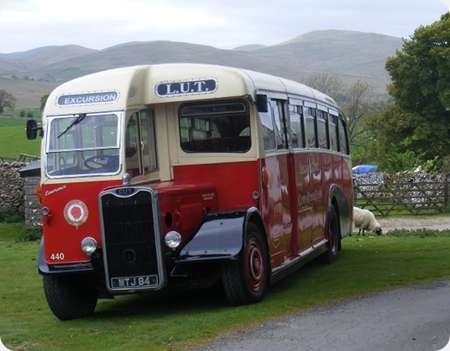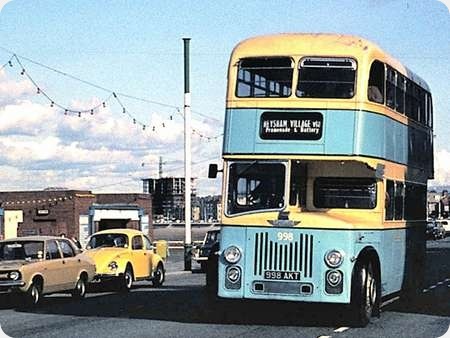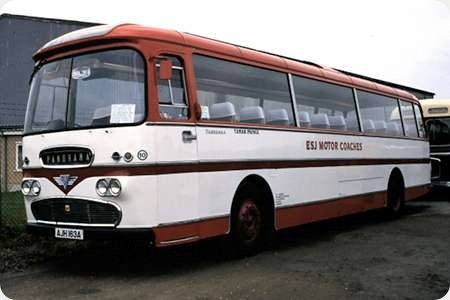Lancashire United Transport – Guy Arab III – MTJ 84 – 440
Lancashire United Transport
1951
Guy Arab III 6LW
Roe C35F
MTJ 84 was originally Lancashire United 440. It is a 1951 Guy Arab III with Roe C35F body. It is owned nowadays by Cumbria Classic Coaches, and is regularly used for private hire work especially weddings. It is seen here at Bowber Head, near Kirkby Stephen, just outside the Cumbria Classic Coaches Depot.
Photograph and Copy contributed by Don McKeown
23/11/15 – 06:37
Another example of a somewhat anachronistic purchase by a major operator. By 1951 the underfloor engined single decker was becoming well established especially for coaches where being up to date with ‘fashion’ was more important than for buses. No doubt these were robust and reliable vehicles but very soon after purchase they would be perceived by the travelling public as very old fashioned. They did have long service lives however and spent a lot of their time on the long Tyne-Tees-Mersey service which in pre-motorway days must have been an arduous trek.
Philip Halstead
26/11/15 – 10:41
I can confirm the arduousness of the X97 in pre motorway days. We were regular travellers in the early sixties from Newcastle to Lymm Church, usually in summer. The usual trip was the 8.30 am departure from Newcastle Haymarket which from memory got to Lymm around teatime. We started queuing about an hour before the scheduled departure time in order to get on the first coach. This was usually a Northern Willowbrook bodied Tiger Cub or Reliance, or one of North Western’s black tops Reliances. They looked impressive but were basically 43 seat buses with detachable headrests on the seats.
The only bit of dual carriageway in the early days was on the A1 south of Catterick. Being a bus nut, I grabbed the front seat armed with my British Bus Fleets volumes much to the amusement of the crews.
One early lessons we learnt was never do the northbound journey on a summer Saturday. We did it once on a miserable wet day. LUT Guy Arab bus to Manchester, then on to a hired Yeates bodied Bedford to Leeds, then another change to get home.
Happy days.
Richard Slater
27/11/15 – 06:24
The livery shown here is very bus-like, the original livery with "brightwork" was much more coach like. LUT bucked the trend with its coach purchases. The first underfloor engined coaches were very sturdy looking centre entrance Roe bodied Guys which arrived in the black & red livery with brightwork (which was soon changed). The next deliveries included Weymann DP Guys and Roe DPs on Atkinson Alpha chassis. (The Atkinsons technically belonged to South Lancashire Tramways.) Add to these Duple Donnington and NCME bodied Tiger Cubs, Burlingham & Plaxton Derwent AEC Reliances, so waiting for an LUT coach in the 60s was most interesting!
Andrew Gosling
27/11/15 – 06:24
Richard, I can’t comment on the Northern Willowbrook bodied vehicles’ seats but the North Western bodied Reliances’ headrests were part of the moulded seat frame and were not detachable.
Phil Blinkhorn
28/11/15 – 06:06
Phil, I recall the high backed moulded seats, and I’m sure they had detachable headrests added. From memory they were white, but we’re talking 50 years ago and my memory could well be defective.
Richard Slater
28/11/15 – 06:06
I wish I’d paid more attention in their day to a number of underfloor single-deckers that are now rarities. Sentinels, Atkinson Alphas, Dennis UFs and Seddons and others come to mind, but at the time I found them a bit unappealing in comparison with halfcabs like this magnificent Roe-bodied Guy and the equally superb Leyland PS1 in the next posting. Underfloors obviously met an operational need, making OPO possible and fitting in an extra 4 seats, but they kept the fitters busy.
Ian Thompson
28/11/15 – 08:27
Not wishing to throw a spanner in the works, a study of the "black top AECs" photos in "North Western" volume 2 by Eric Ogden makes interesting viewing.
Page 54, 720-39, Reliance/Weymann, slightly higher backed seats, no head restraint.
Page 56, 746-60, Reliance/Willowbrook, slightly better moulded seats, no head restraint.
Page 59, 797-811, Reliance/Willowbrook, 804 clearly has white head restraints 797 head restraints, not good photo, but maybe not white or just dirty.
Page 63, 852-871, Reliance/Willowbrook, 864 moulded seats, no head restraints 862 white detachable head restraints retro fitted.
This should clarify the issue!
Andrew Gosling
29/11/15 – 05:53
Thanks Andrew, I have that book and maybe I should have dug it out.
Richard Slater
30/11/15 – 06:44
Richard’s recollection of the timings for his travels on the Newcastle-upon-Tyne to Lymm ‘Tyne-Tees-Mersey’ service are quite right.
The Summer 1951 timetable shows an 0830 departure from Haymarket and the arrival in Lymm would be 1616. The Winter 1969/1970 timetable shows the departure at 0840 arriving 1618.
Both these timetables, plus others from 1932 and 1972 including the vehicle/crew diagram for 1972, may be viewed on my Ipernity album covering the ‘Tyne-Tees-Mersey’ subject. www.ipernity.com/doc/davidslater
David Slater
03/12/15 – 10:38
David, thanks for confirming that my memory isn’t that faulty, it’s reassuring. I last used the X97 around 1968 and I can’t recall ever using the M62. My last trip from Lymm was in a Northern F registered Leopard with, I think, a Willowbrook bus body. It had very comfortable coach seating so a smooth journey was ensured. We used the night service once. This ran via Irlam and Eccles. It was a Yorkshire Woollen car, a DP Reliance, which got into Newcastle ridiculously early because it ran non stop from Leeds. This was quite a common event when the service car was filled with passengers for Newcastle.
Richard Slater
Quick links to the - Comments Page - Contact Page - Home Page



